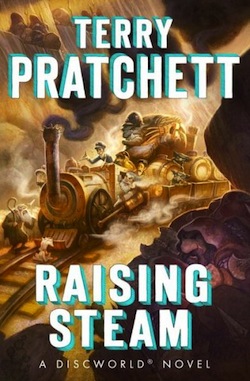“A tree can not find out, as it were, how to blossom, until comes blossom-time. A social growth cannot find out the use of steam engines, until comes steam-engine-time.”
So wrote Charles Fort in Lo!, coining a phrase that historians and SF&F writers love. Well, steam-engine time has come for the Discworld, whether the History Monks like it or not. In Raising Steam, Terry Pratchett takes his turtle-borne world full tilt into its own industrial revolution.
The key moment comes when an astute young man named Dick Simnel manages at last to harness the power of steam, thanks to mental precision and attention to detail that his father before him lacked, leading to his father’s disappearance in “a cloud of furnace parts and flying metal, all enveloped in a pink steam”. He bottles this power into an engine on wheels that he dubs Iron Girder, which he brings to Ankh-Morpork—“the place where things ’appen”. It doesn’t take long for the mercantile minds of the city to see the potential in this invention, and it soon falls to Moist von Lipwig, postmaster, banker, and barely-reformed scoundrel, to expedite the laying of steel tracks of the Ankh-Morpork and Sto Plains Hygienic Railway.
Progress is never easy, however, and the most determined opposition comes in the form of the grags, fundamentalist dwarves who don’t hold with the modern business of machinery or the clacks (the Discworld version of the telegraph), and who rail against young dwarves going to live in the city, where they might actually befriend trolls. The internecine conflicts amongst the dwarves soon spill out beyond their mines, and eventually draws Moist and the railway right into the middle of an attempted coup d’état.
There is, in fact, quite a lot going on here, and lot of people involved as well. Just about everyone who’s anyone in Ankh-Morpork shows up in Raising Steam: the Patrician, of course, and his clerk Drumknott (who finds an unexpected passion in the new railway); Watch stalwarts Nobby Nobbs, Fred Colon, and Commander Sam Vimes; and correspondents from the Ankh-Morpork Times. Lu-Tze of the History Monks, Archchancellor Mustrum Ridcully, and even Death get cameos. And there are payoffs for a number of setups in previous Discworld novels: the dwarven conflicts are a direct consequence of the dwarf-troll treaty that ended Thud!, and the goblins introduced in Snuff have made themselves thoroughly at home in the Ankh-Morpork economy. An easy jumping-on point for the new Discworld reader this is emphatically not.
Indeed, there’s a sense of the Discworld having reached a tipping point. What began with a farcical satire of pseudomedieval fantasy has become a Dickensian mirror of contemporary western society, such that at times it barely even feels fantastical anymore. The grags have their own obvious parallels in nearly any fundamentalist movement going today (some readers are inevitably going to interpret them as Islamic, but conservatism and fear of change ultimately knows no religion or nationality). There are acts of terrorism, political gamesmanship, and capitalism in full flower.
Not that the magic has gone out of the place entirely, though—this being the Disc, Dick Simnel’s care and the admiration of the populace invests Iron Girder with a kind of divinity, even consciousness, which perhaps speaks to our own relationship to technology. “I am no longer just an artefact put together by clever engineers,” Moist is informed by a rather spooky voice near the end of the novel. “I am an idea, a something made of nothing, whose time has come to be. Some might even call me ’goddess’.”
Tonally, Raising Steel continues in the darker vein of the likes of Snuff, which may not be to the taste of all Pratchett fans. The humor is drier, and a lot of minor or unnamed characters end up dead or pretty badly injured. Pratchett takes his time in getting to the collision between the railway and the crisis amongst the dwarves, and as the railway rambles its way across the Sto Plains and the tension rises in Uberwald, for a good long while it’s hard to see exactly how they’re going to come together. Disparate as the two plot threads are, it should be noted that both are emphatically concerned with the forward momentum of history and society, and the ways in which those who refuse to move with the times will get quite thoroughly left behind. Ankh-Morpork and its people—human, dwarf, troll, goblin, werewolf, or other—are the scions of liberal progress and tolerance, and it’s pretty clear where Pratchett’s chiefest sympathies lie.
Raising Steam leaves the Disc thoroughly transformed, with more changes plainly on the horizon as a goblin introduces Vetinari to a contraption consisting of “two wheels held together by not very much”. Knowing what one does about Pratchett’s “embuggerance,” one might feel a twinge of dread that this novel could be a swan song to the Disc. It’s probably better not to speculate along those lines, though. More importantly, Raising Steam is the latest transformation of a remarkable fictional world that has evolved and grown with its creator—and it shows how, in the way of many things invested with devotion on the Disc itself, the Discworld has taken on a life of its own.
Raising Steam is available March 18th from Knopf Doubleday
Karin Kross lives and writes in Austin, TX. She can be found elsewhere on Tumblr and Twitter.










